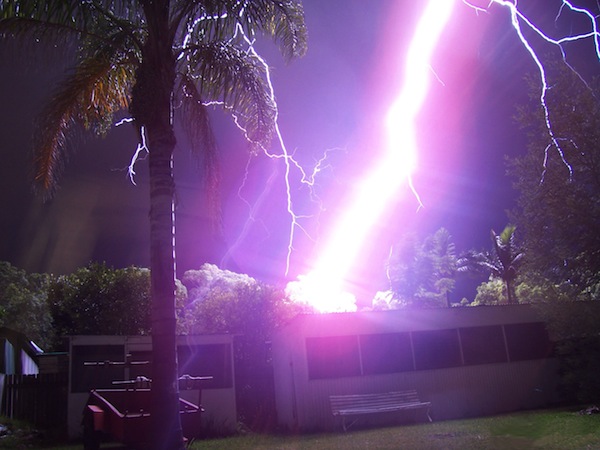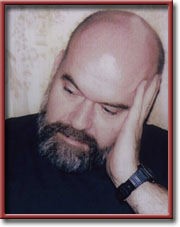Like the Postman, Lightning Always Rings Twice

“The season of electrical storms is once again upon us here in Central Florida. Just a few days ago, a terrifying one broke just around my house, or so it seemed. That hated postman was trying to jab his finger in the doorbell. I turned him away—at least this time.” Sanford Rose
Dolors & Sense
By Sanford Rose

KISSIMMEE Florida—(Weekly Hubris)—7/1/2013—The postman in the James Cain novel is a metaphor for death. If it doesn’t get you the first time, it’ll get you the second time.
Lightning is similarly persistent. Once hit by lightning, you’re vulnerable to a revisit.
I was lucky with my first strike—only a small roof fire, quickly extinguished, although perhaps not so easily its psychological sequelae.
So how to prepare for the second strike?
I got to work on the problem immediately, finally finding a protection contractor who was willing to do what was necessary.
Start with the standard components of a protection system: roof rods to greet the electric current, side conductors to carry the current down the exterior of the house to the ground and electrodes to bury it in that ground.
All contractors more or less provide these elements. The difference between the good and the bad ones is the willingness to: 1) bond all exposed metal roof structures securely to the newly installed side conductors; and 2) sink the electrodes deep enough to permit necessary dissipation of the current.
Roof metal that is not bonded with luxuriantly braided aluminum or copper wire to the newly installed side conductors poses the threat of side flashes that lead to house fires. Electrodes that are not sunk deeply enough will cause current to bounce back from the earth to the house, also leading to potential disaster.
Your run-of-the-mill protection contractor is not big on either bonding or grounding. Left to his own devices, he will scant the job of linking all exposed roof metal to the side conductors. He won’t use the normally required three earthing electrodes. Nor will he sink his electrodes the ten feet needed in loamy clay, not to speak of the 20 or more feet required in sandy, less electrically conductive, soil.
My man is different. Together, we went over all the components of good protection, and he invited me to supervise the installation. Where I disagreed with what he was doing, we discussed my criticism, and he often adopted my suggestions.
Importantly, when the job was done, he measured soil resistance with an Ohm meter. Most contractors don’t bother.
The result was excellent: the earth around my house will now readily accept current passed to it by the side conductors.
Recently, it had occasion to trot out the welcome mat. The season of electrical storms is once again upon us here in Central Florida.
Just a few days ago, a terrifying one broke just around my house, or so it seemed.
That hated postman was trying to jab his finger in the doorbell.
I turned him away—at least this time.

Note: The image used to illustrate this column (photo by Jane Quinnell) may be found at http://farm1.staticflickr.com/38/99646512_76b5ac0807_o.jpg.

7 Comments
Alan Ichiyasu
Hi Sanford:
I am a friend of the editor and find the articles on “Hubris” interesting since they are created by people whose professions that I am unfamiliar with. Thus, sometimes a very, different perspective.
Lightening has struck my son (soon to be proffesional golfer, 67) twice. He is very aware that it could strike again. He came to this conclusion after the first strike. Caddies and other golfers are afflicted with this anomaly (twice) of nature and warned he is now become a rod of lightening.
In conclusion, my real question is your feelings, ethos, etc about Mr Jamie Diamon and his business associates at JP Morgan/Chase? My email is listed above. This is the nut. That is if our fearless EIC will let this through the door.
Thank you and will pass the recommendations to my son. He’s a little uptight about thunderstorms!!!
Alan
Elizabeth Boleman-Herring
Alan, I hope Sanford receives your comment above. I’m offline for abut ten days, and always alert him when a comment goes up/cannot do that from darkest SC right now. He WILL, though, get back to you. :-) eb-h (PS Sanford, Alan and I went to prep school together in Chicago, in another century entirely.)
S. Rose
I assume 67 is your son’s golf score, not his age. Anyone out on a golf course in an electrical storm is in danger of being struck. So the best advice is to seek shelter in a protected structure at the first sign of activity. If you’re caught in the open, try to make yourself as small as possible. Keep arms rigidly at sides and bend at the knees–unfortunately, not a posture that can be sustained for a prolonged period. Avoid a prone position. Don’t shelter under a tree, and certainly not under the biggest tree on the course.
As for my view on Mr. Dimon: I was genuinely shocked when the London whale scandal broke. I had thought better of him. The news was like, what shall I say, a bolt from the blue. But note that banks take risk in various parts of their book of business. Chase took less interest rate and credit risk than most. It made up for that by taking too much risk in its trading operation. It got caught.
S.Rose
Alan Ichiyasu
EIC:
IS CHARLESTON LIKE A J. CONRAD THING? I AM PATIENT AND IF HE RESPONDS, GREAT!
ALAN
Alan Ichiyasu
THANK YOU SANFORD: THE JP’s “WHALE” HAD AN EFFECT UPON MY TRADING HOUSE, MAN FINANCIAL. I BELIEVE YOU ARE AWARE THAT CHASE MOVED FUNDS FROM CORPORATE AND PROBABLY RETAIL CLIENTS FROM NYC TO LONDON TO ASSIST A LARGER POSITION TO RECOVER LOSSES TO NO AVAIL. THUS, MY TRADING FUND BECAME NON-EXISTENT AND COULD NOT BE RECOVERED SINCE “MAN” DECLARED CHAPTER VII. ALSO, I OPTED WITH CHASE TO PAYOFF MY MORTGAGE WITH AN EXPEDITIOUS ANNUAL PAYOFF OF 13 MONTHS WHICH BECAME ANYWHERE FROM 15 – 17 MONTHS ANNUALLY. MY FAULT. A MISTAKE WHICH I SHOULD HAVE BEEN AWARE OF JUST BY REVIEWING MY STATEMENTS. THEY LOCKED ME INTO AN UNAUTHORIZED 30 YR SECOND @10% & PLUS. WITH A SIGNED CONTRACT @ 5 & 3/8. I HEARD MR DIAMON WAS INDICTED BY THE WHITE HOUSE? A MORE EGREGIOUS EPISODE OCCURRED WITH CHASE AND PEREGRINE FINANCIAL (DERIVATIVE HOUSE). THE PRINCIPAL ABSCONDED WITH MY TRADING FUNDS AND WAS PROVEN GUILTY W/SWIFT INCARCERATION. AGAIN, “ZIPPO” RETURN. JP MORGAN/CHASE DECLINED TO ABSORB MY LOSS. THANK YOU FOR READING & TOLERATING MY INTERACTION WITH YOUR FORMER EMPLOYER…IAN, THE SHOOTER AT 67 WILL RECEIVE ALL YOUR RECOMMENDATIONS. LIKE I SAID, “HE’S NERVOUS ABOUT DISCHARGE”. MOST EXCELLENT HOMEWORK. IN CONCLUSION, I HOPE THE”EIC” WILL ALLOW THIS TO BE FORWARDED TO YOU. YOURS TRULY, ALAN ICHIYASU
Alan Ichiyasu
MY THANKS TO THE “EDITOR-IN-CHIEF”.
S. Rose
Perhaps some insight into Chase’s problems, as well as that of banks in general, is provided in my posting in this e-zine of May 28, 2012: “CHASEing Elusive Profits.”
Best
Sanford Rose